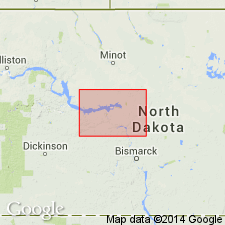
- Usage in publication:
-
- Dead Man drift, till
- Modifications:
-
- Named
- Dominant lithology:
-
- Till
- Gravel
- Silt
- AAPG geologic province:
-
- Williston basin
Summary:
Named as an informal "inferential" (rather than lithostratigraphic) unit of Coleharbor Formation (new) for Dead Man Coulee, at Lake Sakakawea, McLean Co, ND, Williston basin. In ND most named drift units are generally indistinguishable on a regional scale though they can be related to a particular event in the history of a glacier. As drift units are recognized mainly on the basis of their inferred geologic history or origin, they are highly interpretive. All drift units in ND are included within the Coleharbor. Dead Man is exposed along shore of Lake Sakakawea in secs 14, 15, 22, 23, 24, and 27, T147N, R84W; also exposed in NESE, sec 21, T144N, R83W on north side of Missouri River trench. Consists of at least two facies: lowermost is 5-10 ft of iron-stained and poorly cemented gravel that grades to bedded silts; uppermost is mainly silty to clayey till (Dead Man till), 20-30 ft thick, oxidized to yellowish-buff color with irregular gray mottling. Lower contact is submerged in most places though overlies bedrock in one exposure; underlies Mercer drift (new) of Coleharbor. Composite section. Pre-Wisconsinan (Pleistocene) age.
Source: GNU records (USGS DDS-6; Denver GNULEX).
For more information, please contact Nancy Stamm, Geologic Names Committee Secretary.
Asterisk (*) indicates published by U.S. Geological Survey authors.
"No current usage" (†) implies that a name has been abandoned or has fallen into disuse. Former usage and, if known, replacement name given in parentheses ( ).
Slash (/) indicates name conflicts with nomenclatural guidelines (CSN, 1933; ACSN, 1961, 1970; NACSN, 1983, 2005, 2021). May be explained within brackets ([ ]).

